SECURITY FEATURES
I. Substrate
When we look at a certain banknote, the first thing that comes to our eyes is often the substrate, i.e., the material on which the banknote is being printed. Unlike the regular banknotes we use in everyday life, banknotes issued by micronations usually adopt rather simpler materials in order to facilitate the printing process and also reduce its costs, albeit some micronations also use specialized materials to enhance the aesthetics of their banknotes or as a security measure against counterfeiting. To summarize, these substrates can be briefly categorized into two broad groups, i.e., paper and polymer, whereas either group consists of a series of slightly different variants.
Matte paper: In terms of paper types, matte paper has been adopted by the vast majority of the micronational community as the banknote substrate due to its ubiquity and cheapness. This refers to not only the multipurpose plain paper that we use on a regular basis for copying and printing, but also any types of colored paper, sticker paper, cardstock, etc., that comes with a dull finish (i.e., without a shine).

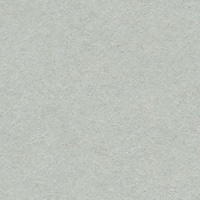
Coated paper: Contrary to matte paper, coated paper comes with a glossy finish and is often used for magazines and marketing materials. Some micronations choose to print their banknotes on coated paper as the product often has a brighter and much more contrasting color scheme than those printed on plain paper. Micronations that have used coated paper for their banknotes include Frioul, Lehmark, etc.
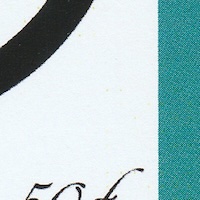
Coated paper (LEH6)
Laid paper: Sometimes considered as a type of watermarked paper, laid paper refers to the type of paper with a ribbed texture (i.e., with horizontal or vertical lines), which can often be seen when held against light. Laid paper is typically used for high-quality invitations and business cards, and may come with real watermark revealing its manufacturer, e.g., Conqueror®. Micronations that have used laid paper for their banknotes include Christiania, Elleore, etc.
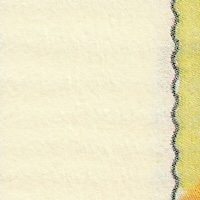
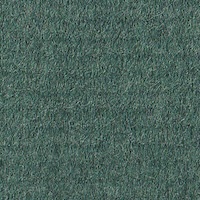
Laid paper (CHRT25 & ELL55)
Linen paper: As the name suggests, linen paper refers to the type of paper having a texture resembling that of linen fabric (i.e., with horizontal and vertical lines). Unlike laid paper, the linen-like texture of linen paper is not reflected through watermark, but only through the finish of the paper, even though it may still come with watermark of the manufacturer. Linen paper is often used for gift wrapping, as well as high-quality envelopes and book covers. Micronations that have used linen paper for their banknotes include Fidelis, Molossia, etc.
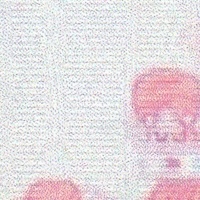
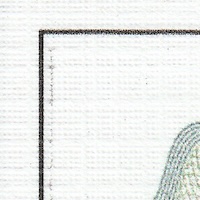
Linen paper with different textures (FID2a & MOL7)
Parchment: Parchment paper refers to a type of high-quality paper that is made to look like real parchment. Used primarily for artistic purposes, it often has a brown to beige color and sometimes also a relatively coarse finish. Micronations that have used parchment paper for their banknotes include Elleore, Ruritania, etc.
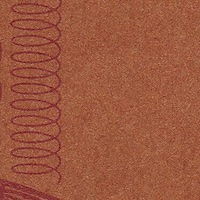
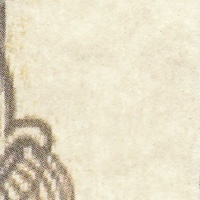
Imitation parchment paper (ELL65 & RURB3)
Other types of specialty paper: Apart from the types of paper discussed above, a few micronations have also used specialty paper with other types of composition or texture for their banknotes. These include, for example, Elleore (printed on specialty paper with an eggshell texture), Fidelis (printed on pearlescent paper with a melon-like finish), Hay (printed on recycled paper), Kosgna (printed on plastic-coated art paper), Saint-Castin (printed on specialty paper with a cardstock texture), Valbona (printed on photo paper), etc. For security paper with watermark or security thread, see Section II below.
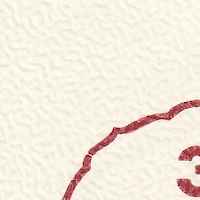
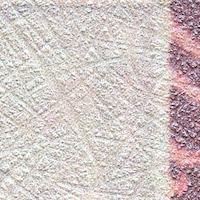
Specialty paper with different textures (ELL61 & FID4b)
Teslin: TESLIN® is a special synthetic paper manufactured by PPG Industries that is often categorized as a particular type of polymer substrates. Most commonly used for product labels, Teslin is very similar to traditional polymer substrates in terms of its outstanding waterproof and tear-resistant quality. Micronations that have used Teslin for their banknotes include Atlantium, ISSA, etc.
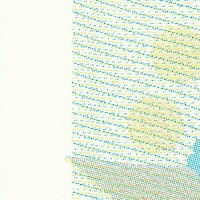
Printing on Teslin (ISA2)
Tyvek: Tyvek® is a type of durable and waterproof synthetic fiber manufactured by DuPont that is often used for festival wristbands, etc. Unlike Teslin, Tyvek was actually used in the 1970s for banknotes of Haiti, the Isle of Man, etc., as an early attempt of producing polymer banknotes before the commonly known polymer substrate was introduced later in Australia. The only micronation that has used Tyvek for its banknotes is Saugeais.
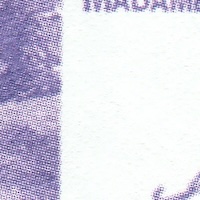
Printing on Tyvek (SAU1)
Polymer substrates: As with banknotes of macronations, those of micronations sometimes also adopt plastic or other polymer substrates for better durability and as an additional anti-counterfeiting measure. Earlier micronational attempts of polymer banknotes tend to use opaque substrates, for instance those issued by the Republic of the Earth and Riviera, whereas more recent ones often use semi-transparent substrates, e.g., those issued by Elleore and Ister.
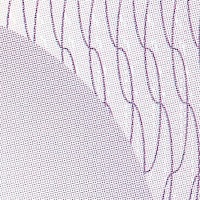
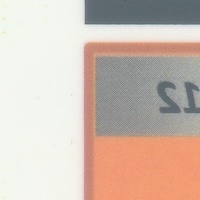
Printing on opaque (RIV1) & semi-transparent polymer (ELL83)
Fabric: Under some rare circumstances, it is also possible for micronations to have banknotes made of cloth or textile, similarly to German notgeld from the WWI period. The only micronations that have ever produced banknotes in the form of fabric are Ivoire of NovaTroie and Zeta Auxvius. Resemling the notgeld, these banknotes often tend to be emergency or souvenir issues that are not part of the regular banknote series.
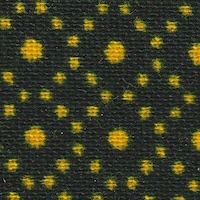
Wax print fabric (NOVR-IVO27)
II. Embedded Features
Some security features are directly embedded in a particular substrate known as security paper, meaning that they are incorporated to paper directly during the papermaking process. The most common ones among these features are watermark, security thread, and fibers, which are widespread among banknotes we use in daily life. Despite its relatively high cost, security paper with these embedded features has also been used by a number of micronations for their banknotes. In some other cases, micronationalists have also found their own way to imitate these features on a tighter budget, e.g., hidden image and security tape.
Watermark: Watermark refers to a hidden pattern or image incorporated to the banknote paper that is visible only when it is held against light. Real watermark can be briefly categorized into general watermark and local watermark: the former is repeated all over the banknote paper, whereas the latter is not repeated and is only revealed on a specific area of the banknote, i.e., the watermark area, which is often purposefully left blank so that the watermark can be easily seen. While general watermark has become somewhat outdated for regular banknotes issued by macronations, it is often preferred by micronations as watermarked paper with general watermark is relatively easier and cheaper to acquire. Typical patterns of general watermark include geometric shapes (as shown on banknotes from Alcatraz and Malu Entu), flowers (as shown on banknotes from Edristan and Litila), etc. On the other hand, although local watermark is the most common type we see on US$ or Euro bills, not so many micronations choose to adopt it for banknotes, as such watermarked paper is often customized and can be extremely expensive for micronationalists. Those that have adopted local watermark for their banknotes include Kamberra, Réunion, etc.
Hidden image: Unlike real watermark, hidden image is not directly incorporated into the paper, but rather inscribed inside the banknote paper. Historically, it is best known for being present on old Tibetan banknotes, which are made from two separate pieces of paper. In this case, the hidden text should first be inscribed reversely on one of them, and then both pieces would be stuck together to form a real banknote. Hidden image is present only on banknotes of Burmania, Kosgna, and Yangina.
Security thread: Fairly common among regular banknotes but less so among micronational ones, security thread refers to a thin metallic strip that is embedded in paper during its manufacturing process. There are two major types of security threads: a latent security thread is completely hidden in banknote paper and can only be seen when it is held against light, whereas a windowed security thread already reveals itself partially on the surface of paper (resembling a dashed line), though it is visible in its entirety only when held against light as well. Micronations that have used security threads on their banknotes include Edristan, Kamberra, etc.
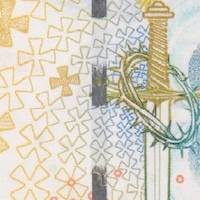
Windowed security thread (KAM109)
Security tape: Unlike security thread (which is completely incorporated into the banknote paper), security tape refers to a decorative and sometimes also transparent band attached to the surface of banknotes. Holographic tape is the most frequently seen type among banknotes of micronations (see Section V for more about hologram), whereas other types of security tapes are only seen on banknotes issued by a handful of micronations, including Cosma, Kamberra, etc.
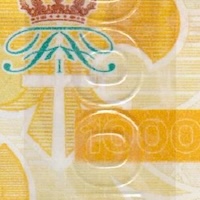
Security tape (KAM109)
Security fibers: Incorporated into the paper during its manufacturing process, security fibers are colored or colorless fibers located randomly in the substrate or on its surface. In some cases, these fibers can also fluoresce under ultraviolet light, thus having an additional layer of security. Security fibers are found on banknotes issued by a number of micronations, for instance the Hajduk Republic and North Barchant.
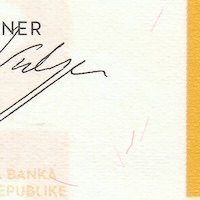
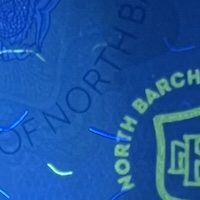
Colored (HRM14) & colorless security fibers (NBA2)
III. Ink
While most micronations nowadays tend to print their banknotes with a normal inkjet printer, it is not rare for some of them to incorporate special inks as an additional security measure, especially those with a larger budget for their banknotes. Despite some subtle differences between brands, special inks can be generally described as either colored (fluorescent ink and iridescent ink) or colorless (invisible ink), all of which are used rather frequently by micronations around the world.
Fluorescent ink: Fluorescent ink refers to a type of ink that contains special pigments that absorb ultraviolet light and immediately re-emit this energy as visible light, thus having a bright, neon-like appearance when exposed to ultraviolet light. While regular fluorescent ink is most often seen on professionally printed banknotes, many micronations also tend to use a yellow or invisible fluorescent pen to achieve a similar effect at a much lower cost. Micronations adopting fluorescent ink on their banknotes include the Antnapolistan, Beaulosagñe, GCWP, etc.

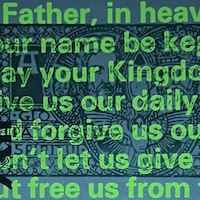
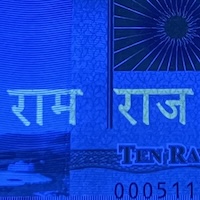
Fluorescent ink (ANT147, BEA10 & GCP3)
Invisible ink: As its name suggests, invisible ink refers to a special type of ink that almost appears colorless under normal environment. While some invisible inks are thermochromic only, most of them also reveal themselves under ultraviolet light, though they do not exhibit any fluorescence and appear much darker than fluorescent inks. Invisible ink is found on banknotes of Antnapolistan, Petonia, etc.
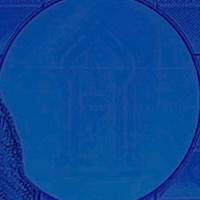
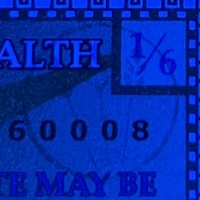
Invisible ink (ANT40 & PET4)
Iridescent ink: Iridescent ink refers to a type of ink that has a glittering and sometimes color-changing luster when viewed from contrasting angles. Although other colors such as blue and green also exist, many iridescent inks come in the color of gold or silver, thus often used by micronations together with the stamping methods introduced in Section IV. Micronations that have used iridescent ink on their banknotes include Edristan, UTNR, etc.
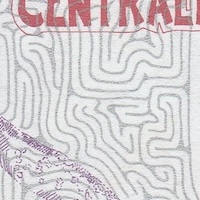
Iridescent ink (UTR4)
Iriodin: Iriodin® is a mica-based pearlescent ink manufactured by Merck KGaA that has a unique natural luster and color effect. On micronational banknotes, it often appears to be a geometric shape or pattern with a semi-transparent to silver-white coating. The only micronations that have used Iriodin on their banknotes are Kamberra (as well as the banknotes produced by Kamberra for other micronations) and Nazland.
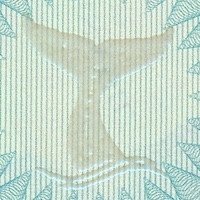
Iriodin coating (KAM103)
IV. Stamping
Stamping often involves a special mark that is being pressed onto the banknote once it has been printed. While the mark pressed is usually an official seal or a date stamp, there is a wide variety of methods by which this mark can be applied to the substrate, from the most commonly seen ink stamping, embossing, to hot foil stamping, which requires a certain degree of professionalism.
Ink stamping: Outside micronationalism, ink stamps have already been used ubiquitously on all kinds of official documents, etc. Apart from rubber stamps and self-inking stamps, for instance on banknotes of Geniusz and Nadiria, it is also very common nowadays for micronations to apply a letterpress or computerized seal to their banknotes once the printing process is completed, such as on those of the GCWP and S.M.O.R.A. Furthermore, it is also very common to apply the method with iridescent ink (i.e., gold, silver, and copper stamping), so that the seal would have shiny, often metallic effect. This is seen on banknotes of Beaulosagñe, NSK, etc.
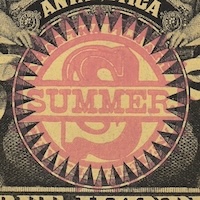
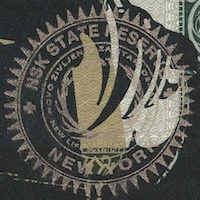
Seals with standard ink (NAD8c) & iridescent ink (NSKB11)
Embossing: While ink stamping results in a mark that is colorful and flat, embossing refers to a method by which the substrate is being pressed via an embosser, thus leaving a colorless dry seal in relief. Micronations that have adopted the method of embossing for their banknotes include Molossia, Xenostrov, etc.
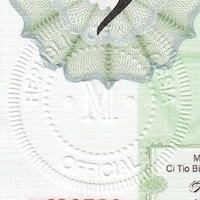
Embossed seal (MOL7)
Raised pattern: A combination of ink stamping and embossing, raised pattern refers to a special mark on substrate that is both raised, i.e., in relief, and often colored. Unlike embossing, raised patterns are not achieved by pressing, but usually through melting of a special type of ink powder, thus only visible from one side of the substrate (though other methods also exist). Micronations that have raised patterns on their banknotes include Kamberra, Litila, etc.
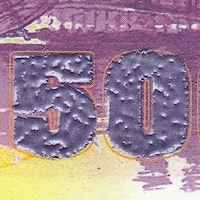
Raised pattern (LIT155)
Foil stamping: Foil stamping or hot stamping refers to the process by which a sheet of metallic foil, often of gold or silver, is forced under heat and pressure to attach to the substrate, leaving a pressed seal that matches the design of the carved die that has initiated this process. Micronations that have adopted the method of foil stamping for their banknotes include the OWK, Riviera, etc.
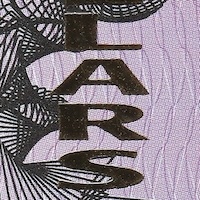
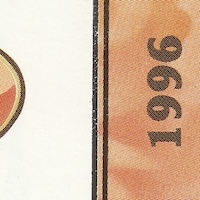
Gold (RIV1) & silver foil stamping (OWK2)
V. Other Add-On Features
A wide range of additional security measures can be applied to banknotes during designing and printing processes. Generally speaking, micronations tend to adopt simpler and more practical security features on their banknotes, the most frequently seen ones of which are as follows.
Engraving: When we pull out a bill from our purse and try to touch the main design or any of the main text, we often feel that the ink on these areas is so thick that it produces relief similarly as embossing. Although extremely common with regular banknotes, this printing technique known as intaglio has never been adopted by any micronations for their banknotes due to the exceptional professionalism it would require. As a reasonable alternative, it is sometimes possible for micronations to at least have an engraved design, usually a portrait, on their banknotes, which however is still printed in the regular fashion. Banknotes designed by the Atlantic Bank Note Company and GabrisBanknote are famous for the professionally engraved portraits, for example those of Atlantium and Seborga.
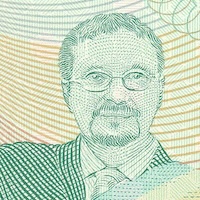
Engraved portrait (ATL4)
Hologram: Hologram usually refers to a small piece of metallic foil or strip bearing a certain pattern or image that glitters or even alters when viewed from a different angle. The holographic foil is often incorporated to the substrate via a method known as hot stamping (see "Foil stamping" in Section IV), but this can be quite costly and require some professional works, thus only afforable for some micronations, such as Aigues-Mortes and Alcatraz. Instead, most micronations simply adopt ready-to-use holographic stickers as a more viable substitute for their banknotes, such as Boshka and Valbona.
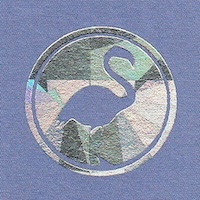
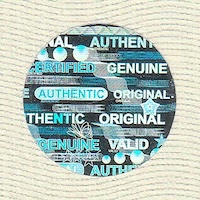
Holographic foil (AIG10) & sticker (BOH12)
Lamination: Lamination refers to the method through which the paper substrate is covered by two welded sheets of transparent plastic films, or sometimes less professionally with transparent tape. Micronations that have adopted the method of lamination for their banknotes include Anthophilia, Wadonstol, etc.
Latent image: Latent image refers to a hidden image on banknote that consists of multiple parallel lines and can hardly be distinguished with naked eyes. This image is sometimes best revealed when the banknote is being tilted. Micronations that have latent images on their banknotes include Atlantium, Kamberra, etc.
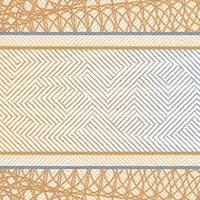
Latent image (ATL3)
Microtext: Microtext or microprinting refers to the extremely small text or patterns printed on banknotes that are barely visible to naked eyes. Technically speaking, microtext must be so small that it can only be seen with a magnifying glass, such as on banknotes of the Atlantium and Pinsk. However, micronational banknotes printed via a less professional printer often have significantly larger microtext, such as those of Landreth and Tír na nÓg.
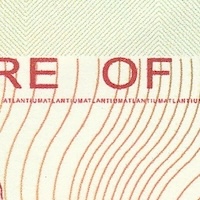
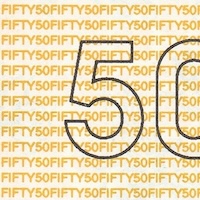
Microtext (ATL4 & LAN7)
Mimeography: Mimeography is an early low-cost duplicating process which involves the use of a mimeograph machine, by which the ink is forced onto paper through a stencil. Micronations that have used mimeography for their banknotes include the UNPEP, etc.
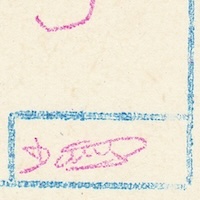
Mimeographed signature (NOV1)
Omron rings: Omron rings or EURion constellation is a geometric pattern consisting of five circles that protects banknotes from being copied or printed by a normal printer. Micronations that have Omron rings on their banknotes include Aerica, Duckionary, etc.
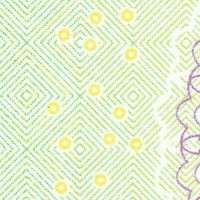
Omron rings (AER1)
Perforation: There are two different types of perforation seen among micronational banknotes - It can be either one or multiple larger holes punched on banknote through a hole punch, or a pattern formed by an array of tiny holes made either manually or by laser (also known as microperforation). The former type of perforation is seen on banknotes of the Arcanum of Relica, Petonia, etc., whereas the latter on those of Kamberra, Landashir, etc.
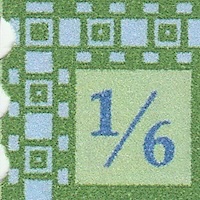
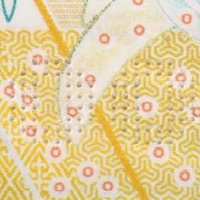
Standard perforation (PET4) & microperforation (KAM109)
Secure window: Secure window (or transparent window) refers to a perforated area on banknote that is covered by a transparent layer of polymer or other similar materials. Among micronational banknotes, this is often done by applying a strip of transparent adhesive tape to one or both sides of the banknote to cover the hole. Secure window is present on banknotes of Kamberra, Kosgna, etc.
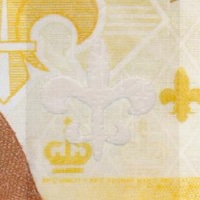
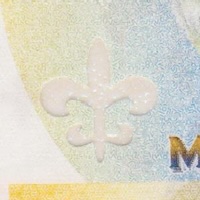
Secure window (KAM109)
See-through register: See-through register refers to an image on banknote, half of which is printed on one side of it and the other half on the other side. When the banknote is held against light, both parts would match up, thus forming a complete image. This technique is seen on banknotes issued by Réunion, Sabina, etc.
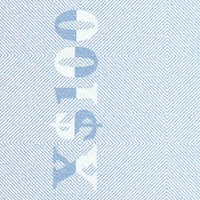
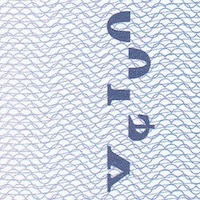
See-through register (REU1)
Serial number: Serial number refers to a unique combination of numbers (and sometimes letters, too) that is assigned to one and only one piece of banknote each time. It can be printed along with banknote itself, alternatively stamped or handwritten on banknote after it has already been printed. Many micronations have serial numbers on their banknotes, such as Elleore, UNPEP, Westarctica, etc. Some micronations have a similar combination of numbers on their banknotes, which remains nonetheless identical on every single piece of the same banknote type - This should not be regarded as a valid serial number.
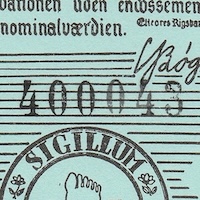
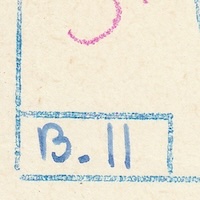
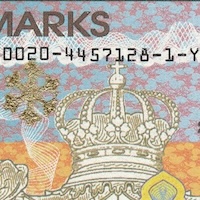
Stamped (ELL32), handwritten (NOV1) & printed serial No. (WES2)
Signature: Handwritten signature is perhaps one of the easiest techniques for micronations to apply to their banknotes. In reality, it is indeed used by numerous micronations around the world, such as Avram, Stratton, etc. In most cases, the signature belongs to their national leaders, whereas others also adopt the signature of the person responsible for the issuance of their banknotes.

Handwritten signature (STR4)
Copyright © 2011-2025 Y. D. Zhang. All Rights Reserved.